ACCT20075 Auditing and Assurance Report - Mineral Resources Ltd.
VerifiedAdded on 2022/11/26
|13
|2684
|369
Report
AI Summary
This report provides a comprehensive analysis of an auditing and assurance assignment focused on Mineral Resources Limited. The report begins with an introduction to materiality, its significance in financial statement audits, and the different methods for calculating it. It then delves into an analytical review of the company's financial statements from 2015 to 2018, examining key ratios related to efficiency, liquidity, profitability, and capital structure. Based on this review and the materiality level, the report identifies key risk areas, associated audit assertions at risk, and relevant audit procedures. The report also reviews the company's statement of cash flows, highlighting major cash inflows and outflows. Finally, it examines the audit report, including the type of opinion issued and any key audit matters identified by the auditors, such as mine development expenditure, provision for site rehabilitation, and inventory valuation. The report concludes that the company has stable audit risk and would be sustainable in long run.
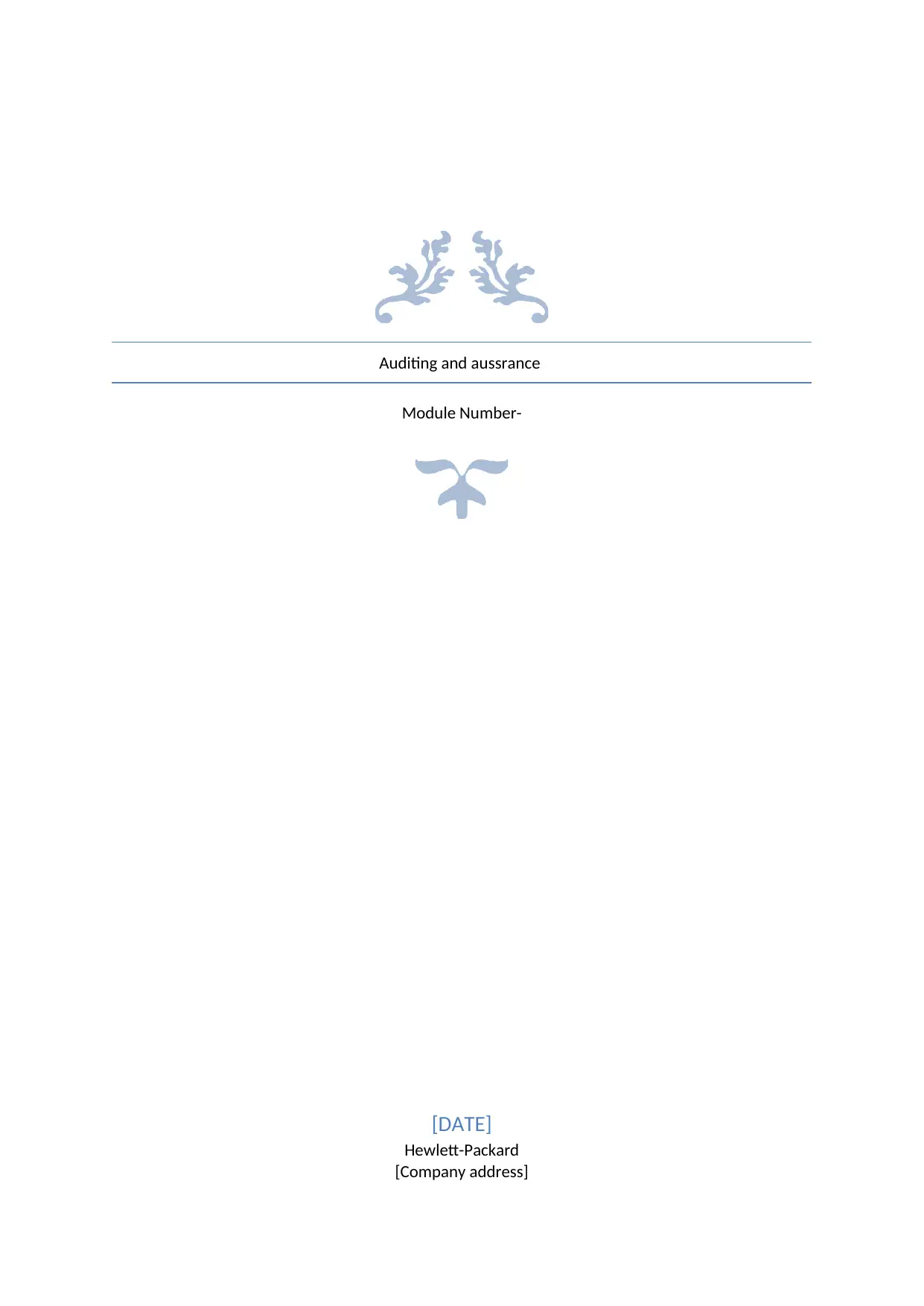
Auditing and aussrance
Module Number-
[DATE]
Hewlett-Packard
[Company address]
Module Number-
[DATE]
Hewlett-Packard
[Company address]
Paraphrase This Document
Need a fresh take? Get an instant paraphrase of this document with our AI Paraphraser
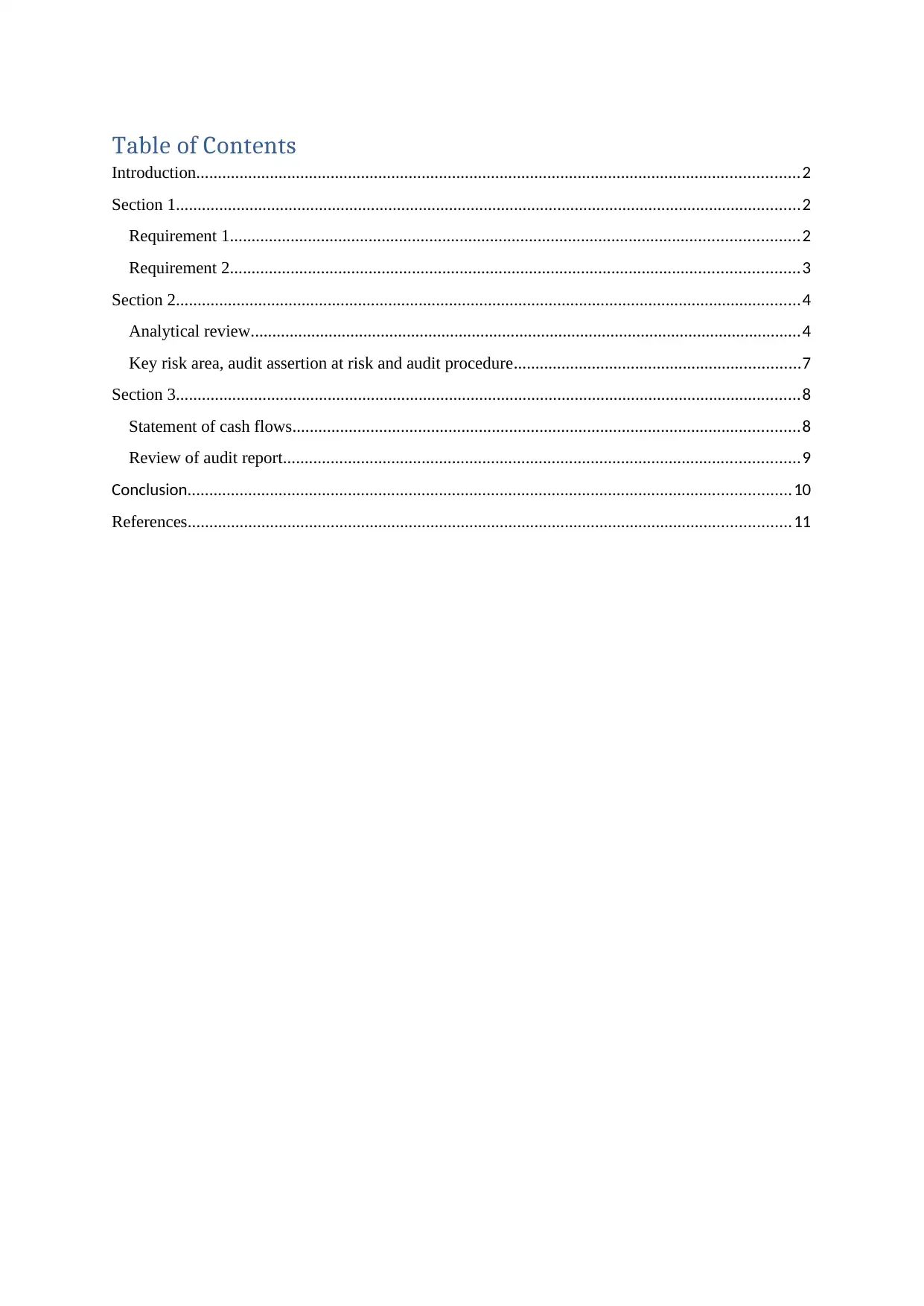
Table of Contents
Introduction...........................................................................................................................................2
Section 1................................................................................................................................................2
Requirement 1...................................................................................................................................2
Requirement 2...................................................................................................................................3
Section 2................................................................................................................................................4
Analytical review...............................................................................................................................4
Key risk area, audit assertion at risk and audit procedure..................................................................7
Section 3................................................................................................................................................8
Statement of cash flows.....................................................................................................................8
Review of audit report.......................................................................................................................9
Conclusion...........................................................................................................................................10
References...........................................................................................................................................11
Introduction...........................................................................................................................................2
Section 1................................................................................................................................................2
Requirement 1...................................................................................................................................2
Requirement 2...................................................................................................................................3
Section 2................................................................................................................................................4
Analytical review...............................................................................................................................4
Key risk area, audit assertion at risk and audit procedure..................................................................7
Section 3................................................................................................................................................8
Statement of cash flows.....................................................................................................................8
Review of audit report.......................................................................................................................9
Conclusion...........................................................................................................................................10
References...........................................................................................................................................11
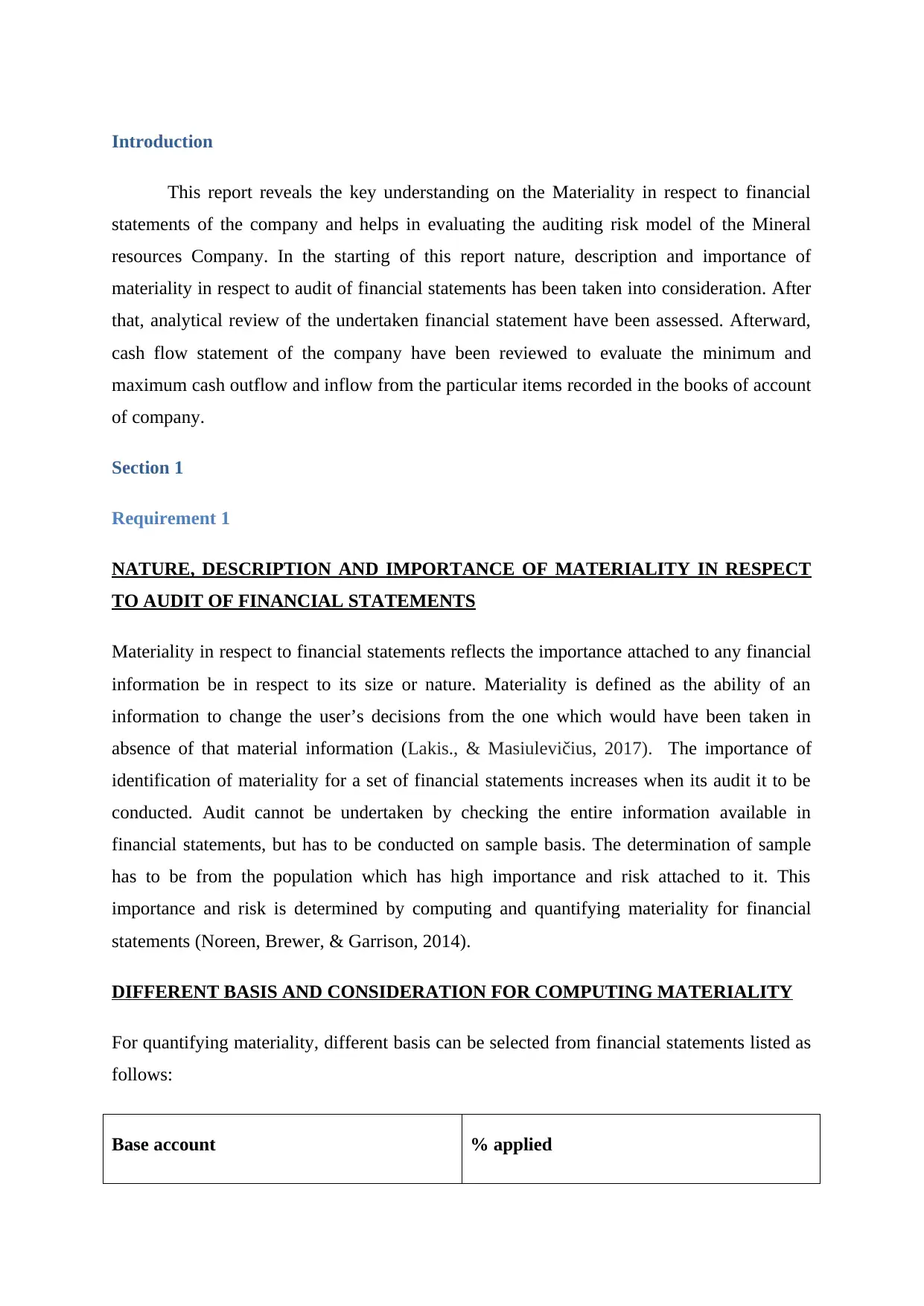
Introduction
This report reveals the key understanding on the Materiality in respect to financial
statements of the company and helps in evaluating the auditing risk model of the Mineral
resources Company. In the starting of this report nature, description and importance of
materiality in respect to audit of financial statements has been taken into consideration. After
that, analytical review of the undertaken financial statement have been assessed. Afterward,
cash flow statement of the company have been reviewed to evaluate the minimum and
maximum cash outflow and inflow from the particular items recorded in the books of account
of company.
Section 1
Requirement 1
NATURE, DESCRIPTION AND IMPORTANCE OF MATERIALITY IN RESPECT
TO AUDIT OF FINANCIAL STATEMENTS
Materiality in respect to financial statements reflects the importance attached to any financial
information be in respect to its size or nature. Materiality is defined as the ability of an
information to change the user’s decisions from the one which would have been taken in
absence of that material information (Lakis., & Masiulevičius, 2017). The importance of
identification of materiality for a set of financial statements increases when its audit it to be
conducted. Audit cannot be undertaken by checking the entire information available in
financial statements, but has to be conducted on sample basis. The determination of sample
has to be from the population which has high importance and risk attached to it. This
importance and risk is determined by computing and quantifying materiality for financial
statements (Noreen, Brewer, & Garrison, 2014).
DIFFERENT BASIS AND CONSIDERATION FOR COMPUTING MATERIALITY
For quantifying materiality, different basis can be selected from financial statements listed as
follows:
Base account % applied
This report reveals the key understanding on the Materiality in respect to financial
statements of the company and helps in evaluating the auditing risk model of the Mineral
resources Company. In the starting of this report nature, description and importance of
materiality in respect to audit of financial statements has been taken into consideration. After
that, analytical review of the undertaken financial statement have been assessed. Afterward,
cash flow statement of the company have been reviewed to evaluate the minimum and
maximum cash outflow and inflow from the particular items recorded in the books of account
of company.
Section 1
Requirement 1
NATURE, DESCRIPTION AND IMPORTANCE OF MATERIALITY IN RESPECT
TO AUDIT OF FINANCIAL STATEMENTS
Materiality in respect to financial statements reflects the importance attached to any financial
information be in respect to its size or nature. Materiality is defined as the ability of an
information to change the user’s decisions from the one which would have been taken in
absence of that material information (Lakis., & Masiulevičius, 2017). The importance of
identification of materiality for a set of financial statements increases when its audit it to be
conducted. Audit cannot be undertaken by checking the entire information available in
financial statements, but has to be conducted on sample basis. The determination of sample
has to be from the population which has high importance and risk attached to it. This
importance and risk is determined by computing and quantifying materiality for financial
statements (Noreen, Brewer, & Garrison, 2014).
DIFFERENT BASIS AND CONSIDERATION FOR COMPUTING MATERIALITY
For quantifying materiality, different basis can be selected from financial statements listed as
follows:
Base account % applied
⊘ This is a preview!⊘
Do you want full access?
Subscribe today to unlock all pages.

Trusted by 1+ million students worldwide
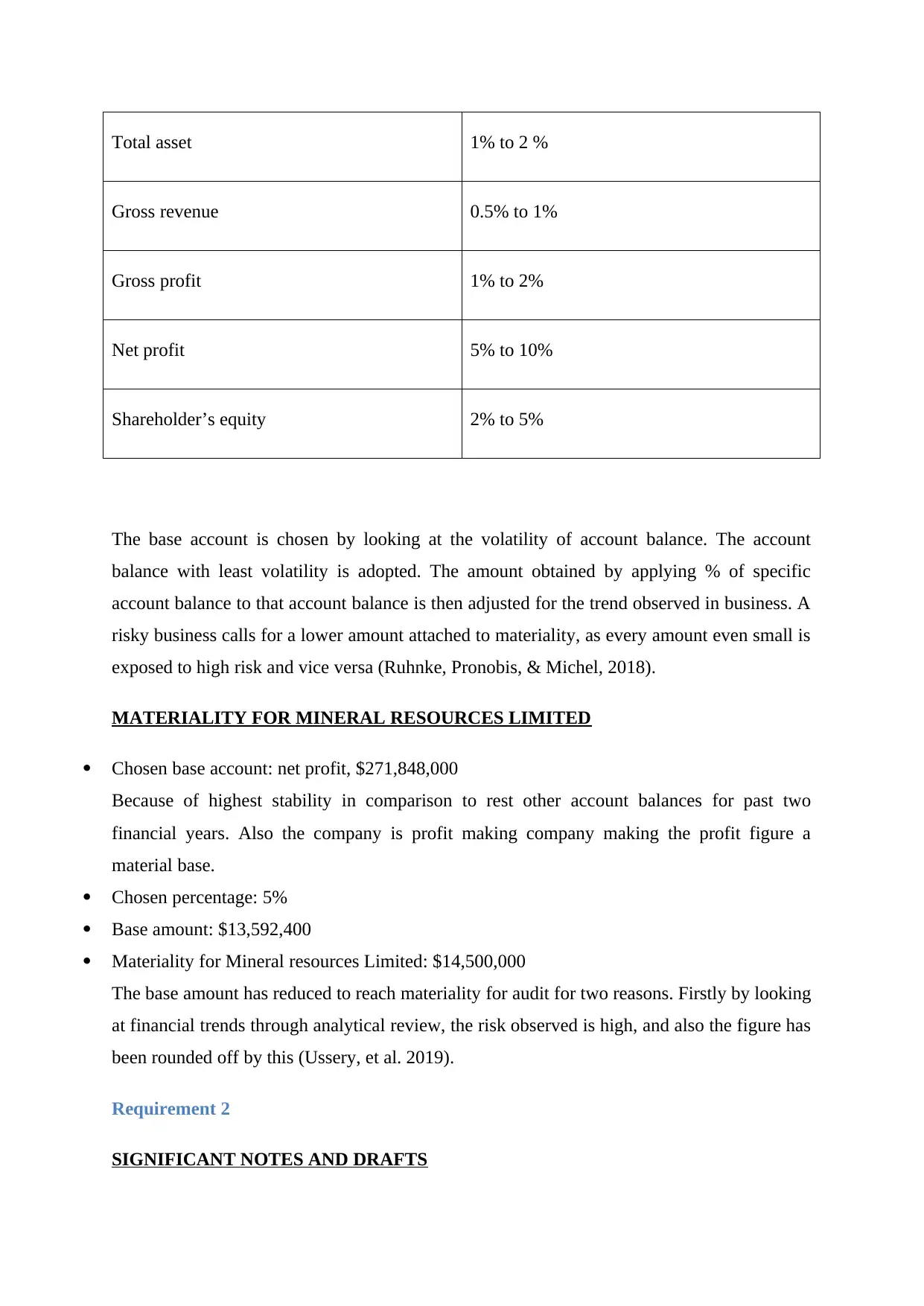
Total asset 1% to 2 %
Gross revenue 0.5% to 1%
Gross profit 1% to 2%
Net profit 5% to 10%
Shareholder’s equity 2% to 5%
The base account is chosen by looking at the volatility of account balance. The account
balance with least volatility is adopted. The amount obtained by applying % of specific
account balance to that account balance is then adjusted for the trend observed in business. A
risky business calls for a lower amount attached to materiality, as every amount even small is
exposed to high risk and vice versa (Ruhnke, Pronobis, & Michel, 2018).
MATERIALITY FOR MINERAL RESOURCES LIMITED
Chosen base account: net profit, $271,848,000
Because of highest stability in comparison to rest other account balances for past two
financial years. Also the company is profit making company making the profit figure a
material base.
Chosen percentage: 5%
Base amount: $13,592,400
Materiality for Mineral resources Limited: $14,500,000
The base amount has reduced to reach materiality for audit for two reasons. Firstly by looking
at financial trends through analytical review, the risk observed is high, and also the figure has
been rounded off by this (Ussery, et al. 2019).
Requirement 2
SIGNIFICANT NOTES AND DRAFTS
Gross revenue 0.5% to 1%
Gross profit 1% to 2%
Net profit 5% to 10%
Shareholder’s equity 2% to 5%
The base account is chosen by looking at the volatility of account balance. The account
balance with least volatility is adopted. The amount obtained by applying % of specific
account balance to that account balance is then adjusted for the trend observed in business. A
risky business calls for a lower amount attached to materiality, as every amount even small is
exposed to high risk and vice versa (Ruhnke, Pronobis, & Michel, 2018).
MATERIALITY FOR MINERAL RESOURCES LIMITED
Chosen base account: net profit, $271,848,000
Because of highest stability in comparison to rest other account balances for past two
financial years. Also the company is profit making company making the profit figure a
material base.
Chosen percentage: 5%
Base amount: $13,592,400
Materiality for Mineral resources Limited: $14,500,000
The base amount has reduced to reach materiality for audit for two reasons. Firstly by looking
at financial trends through analytical review, the risk observed is high, and also the figure has
been rounded off by this (Ussery, et al. 2019).
Requirement 2
SIGNIFICANT NOTES AND DRAFTS
Paraphrase This Document
Need a fresh take? Get an instant paraphrase of this document with our AI Paraphraser
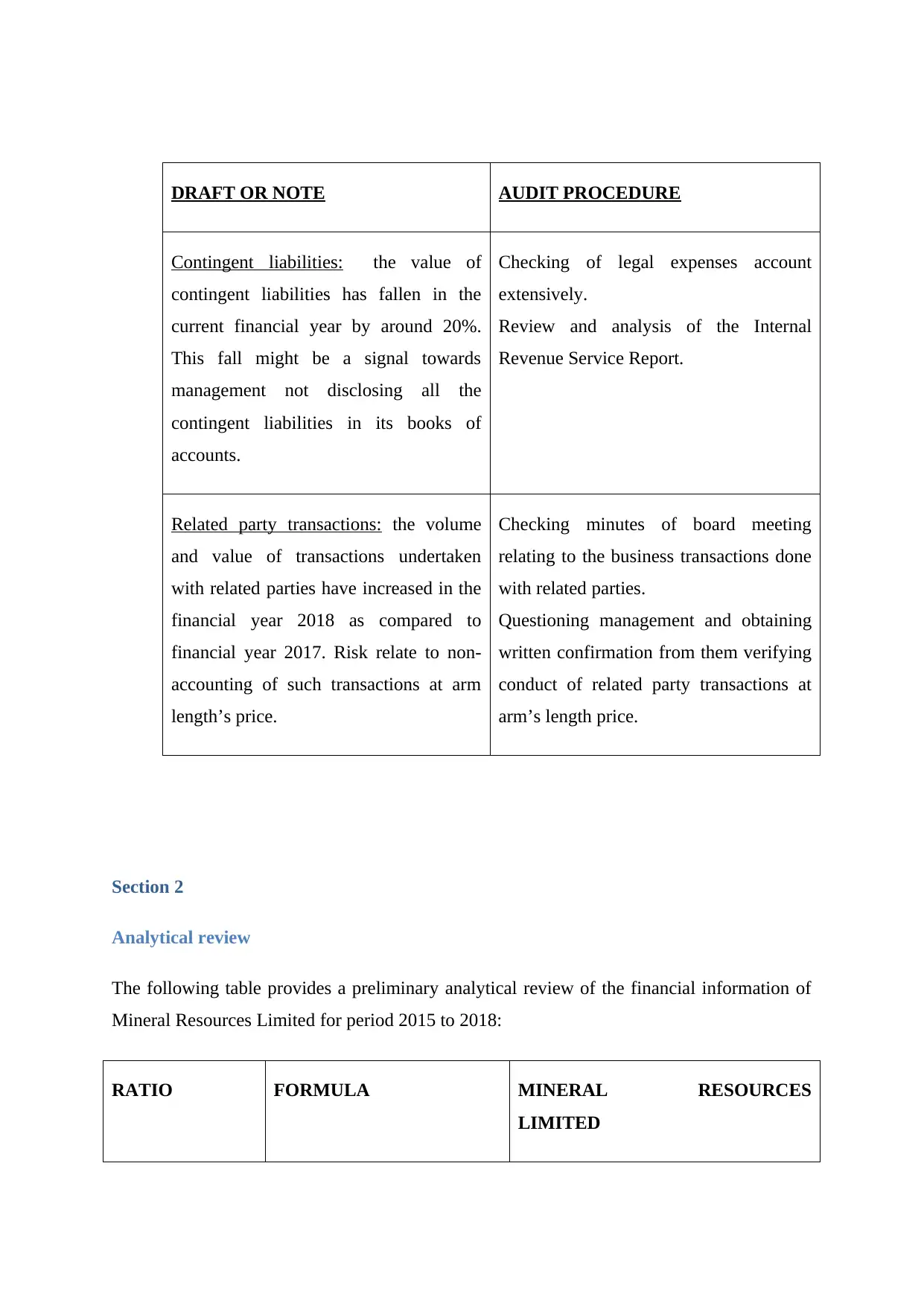
DRAFT OR NOTE AUDIT PROCEDURE
Contingent liabilities: the value of
contingent liabilities has fallen in the
current financial year by around 20%.
This fall might be a signal towards
management not disclosing all the
contingent liabilities in its books of
accounts.
Checking of legal expenses account
extensively.
Review and analysis of the Internal
Revenue Service Report.
Related party transactions: the volume
and value of transactions undertaken
with related parties have increased in the
financial year 2018 as compared to
financial year 2017. Risk relate to non-
accounting of such transactions at arm
length’s price.
Checking minutes of board meeting
relating to the business transactions done
with related parties.
Questioning management and obtaining
written confirmation from them verifying
conduct of related party transactions at
arm’s length price.
Section 2
Analytical review
The following table provides a preliminary analytical review of the financial information of
Mineral Resources Limited for period 2015 to 2018:
RATIO FORMULA MINERAL RESOURCES
LIMITED
Contingent liabilities: the value of
contingent liabilities has fallen in the
current financial year by around 20%.
This fall might be a signal towards
management not disclosing all the
contingent liabilities in its books of
accounts.
Checking of legal expenses account
extensively.
Review and analysis of the Internal
Revenue Service Report.
Related party transactions: the volume
and value of transactions undertaken
with related parties have increased in the
financial year 2018 as compared to
financial year 2017. Risk relate to non-
accounting of such transactions at arm
length’s price.
Checking minutes of board meeting
relating to the business transactions done
with related parties.
Questioning management and obtaining
written confirmation from them verifying
conduct of related party transactions at
arm’s length price.
Section 2
Analytical review
The following table provides a preliminary analytical review of the financial information of
Mineral Resources Limited for period 2015 to 2018:
RATIO FORMULA MINERAL RESOURCES
LIMITED
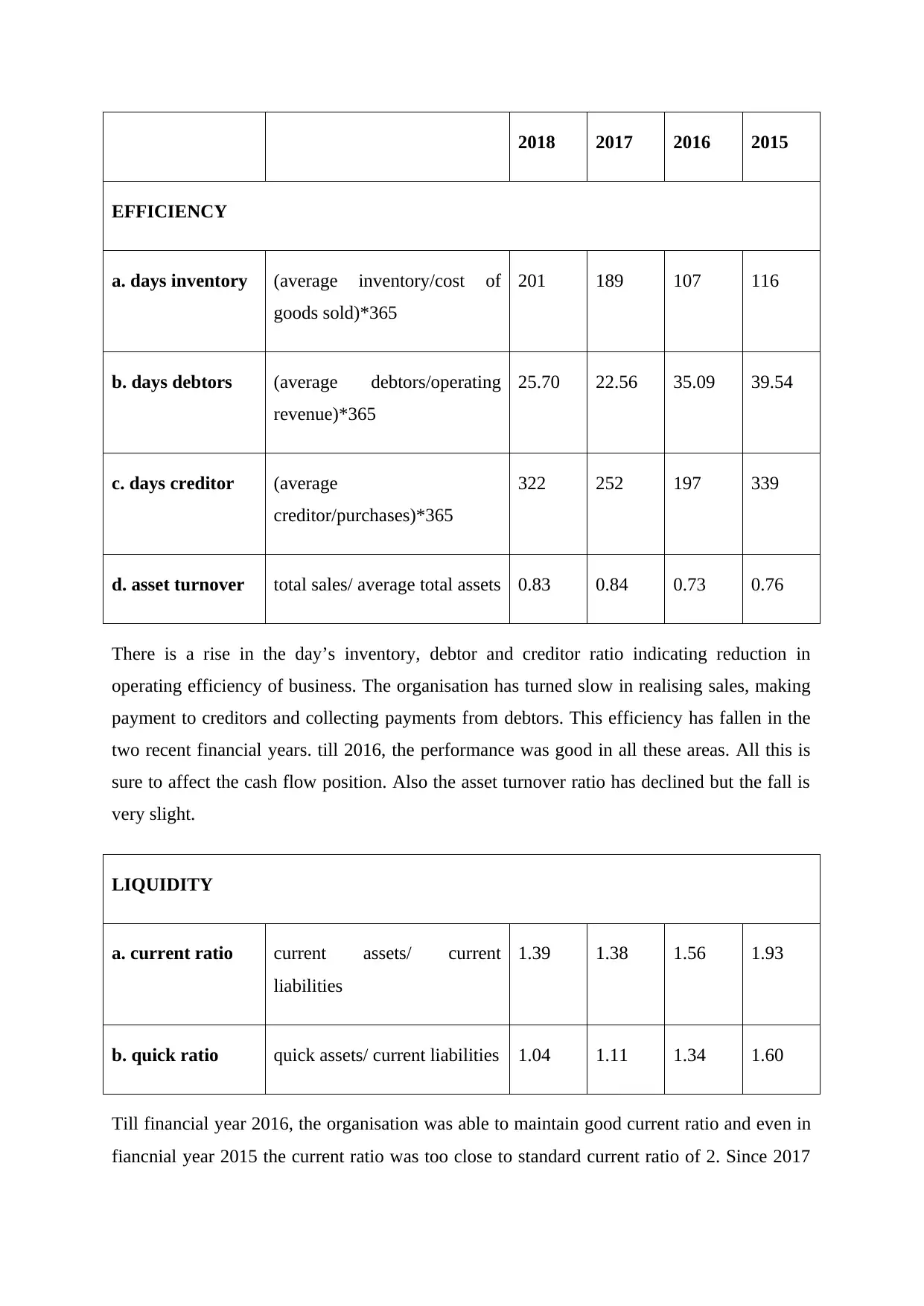
2018 2017 2016 2015
EFFICIENCY
a. days inventory (average inventory/cost of
goods sold)*365
201 189 107 116
b. days debtors (average debtors/operating
revenue)*365
25.70 22.56 35.09 39.54
c. days creditor (average
creditor/purchases)*365
322 252 197 339
d. asset turnover total sales/ average total assets 0.83 0.84 0.73 0.76
There is a rise in the day’s inventory, debtor and creditor ratio indicating reduction in
operating efficiency of business. The organisation has turned slow in realising sales, making
payment to creditors and collecting payments from debtors. This efficiency has fallen in the
two recent financial years. till 2016, the performance was good in all these areas. All this is
sure to affect the cash flow position. Also the asset turnover ratio has declined but the fall is
very slight.
LIQUIDITY
a. current ratio current assets/ current
liabilities
1.39 1.38 1.56 1.93
b. quick ratio quick assets/ current liabilities 1.04 1.11 1.34 1.60
Till financial year 2016, the organisation was able to maintain good current ratio and even in
fiancnial year 2015 the current ratio was too close to standard current ratio of 2. Since 2017
EFFICIENCY
a. days inventory (average inventory/cost of
goods sold)*365
201 189 107 116
b. days debtors (average debtors/operating
revenue)*365
25.70 22.56 35.09 39.54
c. days creditor (average
creditor/purchases)*365
322 252 197 339
d. asset turnover total sales/ average total assets 0.83 0.84 0.73 0.76
There is a rise in the day’s inventory, debtor and creditor ratio indicating reduction in
operating efficiency of business. The organisation has turned slow in realising sales, making
payment to creditors and collecting payments from debtors. This efficiency has fallen in the
two recent financial years. till 2016, the performance was good in all these areas. All this is
sure to affect the cash flow position. Also the asset turnover ratio has declined but the fall is
very slight.
LIQUIDITY
a. current ratio current assets/ current
liabilities
1.39 1.38 1.56 1.93
b. quick ratio quick assets/ current liabilities 1.04 1.11 1.34 1.60
Till financial year 2016, the organisation was able to maintain good current ratio and even in
fiancnial year 2015 the current ratio was too close to standard current ratio of 2. Since 2017
⊘ This is a preview!⊘
Do you want full access?
Subscribe today to unlock all pages.

Trusted by 1+ million students worldwide
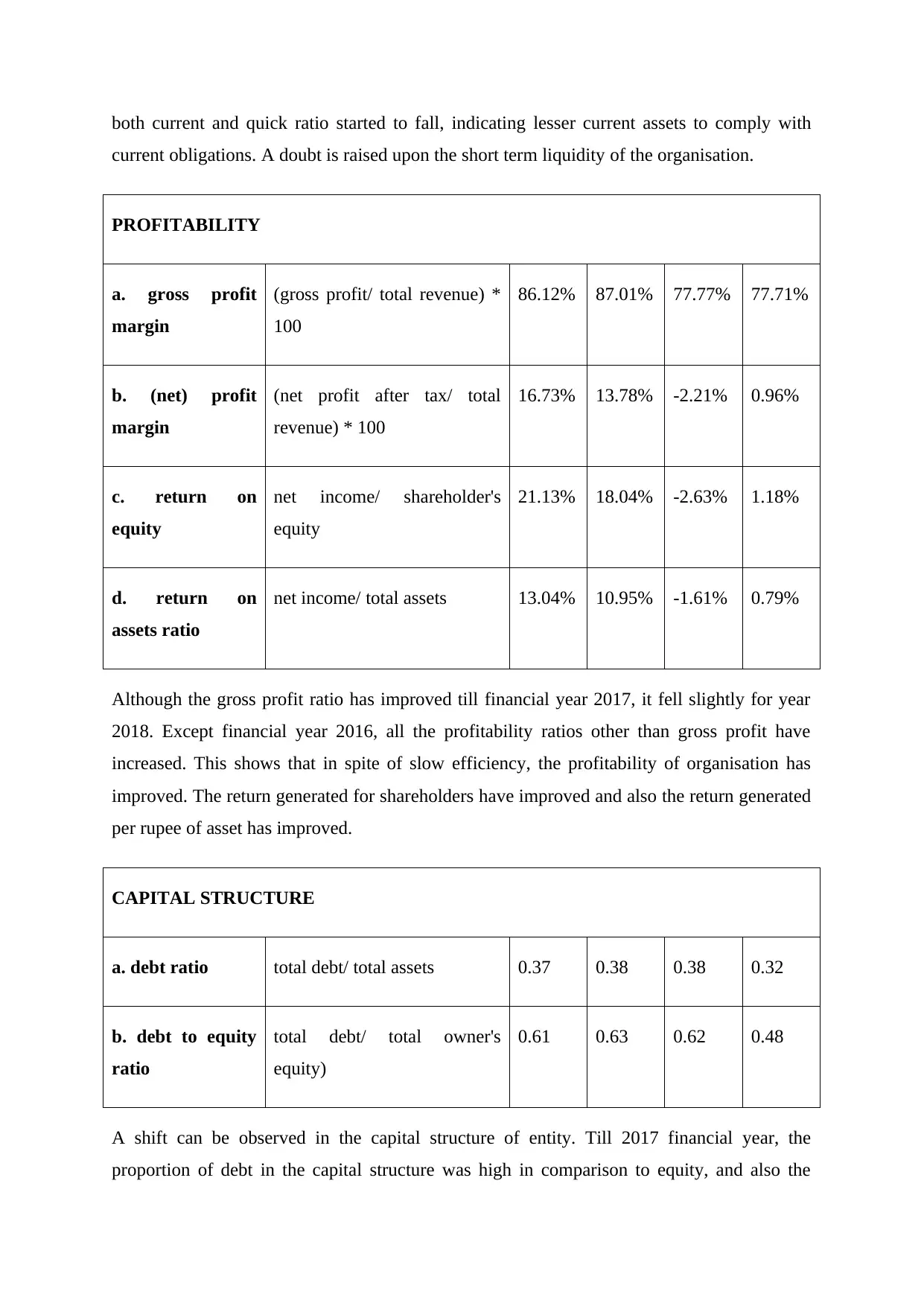
both current and quick ratio started to fall, indicating lesser current assets to comply with
current obligations. A doubt is raised upon the short term liquidity of the organisation.
PROFITABILITY
a. gross profit
margin
(gross profit/ total revenue) *
100
86.12% 87.01% 77.77% 77.71%
b. (net) profit
margin
(net profit after tax/ total
revenue) * 100
16.73% 13.78% -2.21% 0.96%
c. return on
equity
net income/ shareholder's
equity
21.13% 18.04% -2.63% 1.18%
d. return on
assets ratio
net income/ total assets 13.04% 10.95% -1.61% 0.79%
Although the gross profit ratio has improved till financial year 2017, it fell slightly for year
2018. Except financial year 2016, all the profitability ratios other than gross profit have
increased. This shows that in spite of slow efficiency, the profitability of organisation has
improved. The return generated for shareholders have improved and also the return generated
per rupee of asset has improved.
CAPITAL STRUCTURE
a. debt ratio total debt/ total assets 0.37 0.38 0.38 0.32
b. debt to equity
ratio
total debt/ total owner's
equity)
0.61 0.63 0.62 0.48
A shift can be observed in the capital structure of entity. Till 2017 financial year, the
proportion of debt in the capital structure was high in comparison to equity, and also the
current obligations. A doubt is raised upon the short term liquidity of the organisation.
PROFITABILITY
a. gross profit
margin
(gross profit/ total revenue) *
100
86.12% 87.01% 77.77% 77.71%
b. (net) profit
margin
(net profit after tax/ total
revenue) * 100
16.73% 13.78% -2.21% 0.96%
c. return on
equity
net income/ shareholder's
equity
21.13% 18.04% -2.63% 1.18%
d. return on
assets ratio
net income/ total assets 13.04% 10.95% -1.61% 0.79%
Although the gross profit ratio has improved till financial year 2017, it fell slightly for year
2018. Except financial year 2016, all the profitability ratios other than gross profit have
increased. This shows that in spite of slow efficiency, the profitability of organisation has
improved. The return generated for shareholders have improved and also the return generated
per rupee of asset has improved.
CAPITAL STRUCTURE
a. debt ratio total debt/ total assets 0.37 0.38 0.38 0.32
b. debt to equity
ratio
total debt/ total owner's
equity)
0.61 0.63 0.62 0.48
A shift can be observed in the capital structure of entity. Till 2017 financial year, the
proportion of debt in the capital structure was high in comparison to equity, and also the
Paraphrase This Document
Need a fresh take? Get an instant paraphrase of this document with our AI Paraphraser
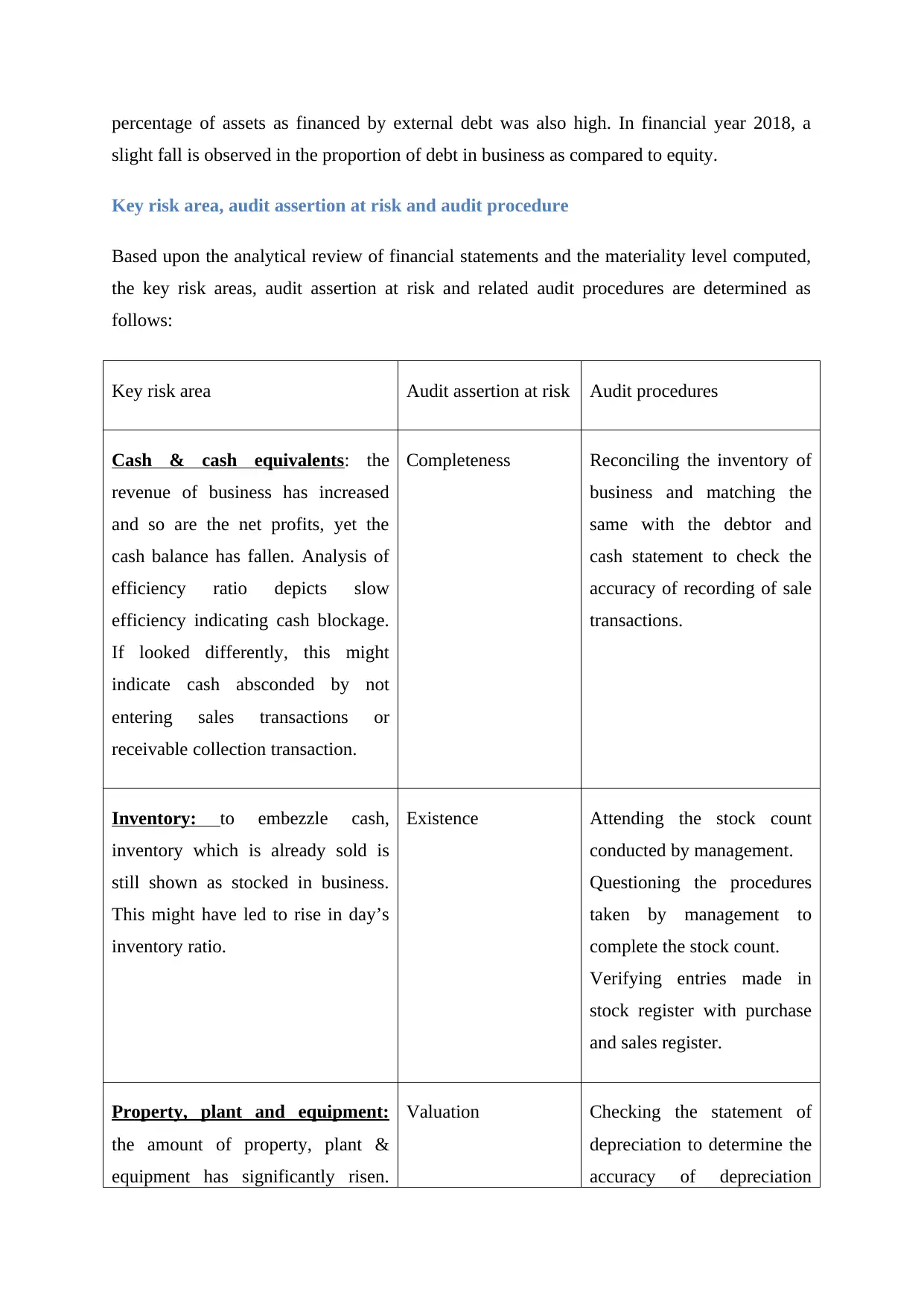
percentage of assets as financed by external debt was also high. In financial year 2018, a
slight fall is observed in the proportion of debt in business as compared to equity.
Key risk area, audit assertion at risk and audit procedure
Based upon the analytical review of financial statements and the materiality level computed,
the key risk areas, audit assertion at risk and related audit procedures are determined as
follows:
Key risk area Audit assertion at risk Audit procedures
Cash & cash equivalents: the
revenue of business has increased
and so are the net profits, yet the
cash balance has fallen. Analysis of
efficiency ratio depicts slow
efficiency indicating cash blockage.
If looked differently, this might
indicate cash absconded by not
entering sales transactions or
receivable collection transaction.
Completeness Reconciling the inventory of
business and matching the
same with the debtor and
cash statement to check the
accuracy of recording of sale
transactions.
Inventory: to embezzle cash,
inventory which is already sold is
still shown as stocked in business.
This might have led to rise in day’s
inventory ratio.
Existence Attending the stock count
conducted by management.
Questioning the procedures
taken by management to
complete the stock count.
Verifying entries made in
stock register with purchase
and sales register.
Property, plant and equipment:
the amount of property, plant &
equipment has significantly risen.
Valuation Checking the statement of
depreciation to determine the
accuracy of depreciation
slight fall is observed in the proportion of debt in business as compared to equity.
Key risk area, audit assertion at risk and audit procedure
Based upon the analytical review of financial statements and the materiality level computed,
the key risk areas, audit assertion at risk and related audit procedures are determined as
follows:
Key risk area Audit assertion at risk Audit procedures
Cash & cash equivalents: the
revenue of business has increased
and so are the net profits, yet the
cash balance has fallen. Analysis of
efficiency ratio depicts slow
efficiency indicating cash blockage.
If looked differently, this might
indicate cash absconded by not
entering sales transactions or
receivable collection transaction.
Completeness Reconciling the inventory of
business and matching the
same with the debtor and
cash statement to check the
accuracy of recording of sale
transactions.
Inventory: to embezzle cash,
inventory which is already sold is
still shown as stocked in business.
This might have led to rise in day’s
inventory ratio.
Existence Attending the stock count
conducted by management.
Questioning the procedures
taken by management to
complete the stock count.
Verifying entries made in
stock register with purchase
and sales register.
Property, plant and equipment:
the amount of property, plant &
equipment has significantly risen.
Valuation Checking the statement of
depreciation to determine the
accuracy of depreciation
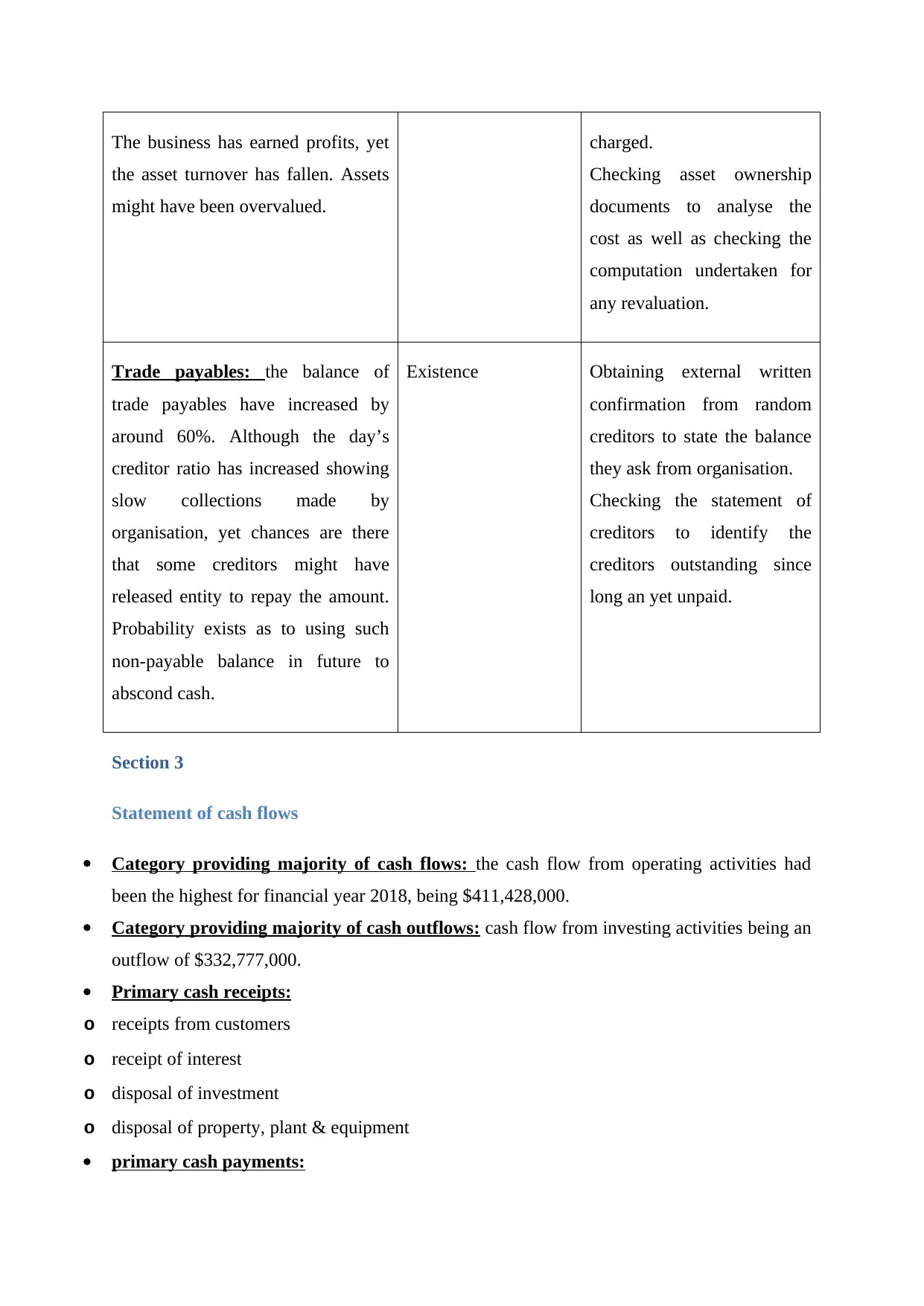
The business has earned profits, yet
the asset turnover has fallen. Assets
might have been overvalued.
charged.
Checking asset ownership
documents to analyse the
cost as well as checking the
computation undertaken for
any revaluation.
Trade payables: the balance of
trade payables have increased by
around 60%. Although the day’s
creditor ratio has increased showing
slow collections made by
organisation, yet chances are there
that some creditors might have
released entity to repay the amount.
Probability exists as to using such
non-payable balance in future to
abscond cash.
Existence Obtaining external written
confirmation from random
creditors to state the balance
they ask from organisation.
Checking the statement of
creditors to identify the
creditors outstanding since
long an yet unpaid.
Section 3
Statement of cash flows
Category providing majority of cash flows: the cash flow from operating activities had
been the highest for financial year 2018, being $411,428,000.
Category providing majority of cash outflows: cash flow from investing activities being an
outflow of $332,777,000.
Primary cash receipts:
o receipts from customers
o receipt of interest
o disposal of investment
o disposal of property, plant & equipment
primary cash payments:
the asset turnover has fallen. Assets
might have been overvalued.
charged.
Checking asset ownership
documents to analyse the
cost as well as checking the
computation undertaken for
any revaluation.
Trade payables: the balance of
trade payables have increased by
around 60%. Although the day’s
creditor ratio has increased showing
slow collections made by
organisation, yet chances are there
that some creditors might have
released entity to repay the amount.
Probability exists as to using such
non-payable balance in future to
abscond cash.
Existence Obtaining external written
confirmation from random
creditors to state the balance
they ask from organisation.
Checking the statement of
creditors to identify the
creditors outstanding since
long an yet unpaid.
Section 3
Statement of cash flows
Category providing majority of cash flows: the cash flow from operating activities had
been the highest for financial year 2018, being $411,428,000.
Category providing majority of cash outflows: cash flow from investing activities being an
outflow of $332,777,000.
Primary cash receipts:
o receipts from customers
o receipt of interest
o disposal of investment
o disposal of property, plant & equipment
primary cash payments:
⊘ This is a preview!⊘
Do you want full access?
Subscribe today to unlock all pages.

Trusted by 1+ million students worldwide
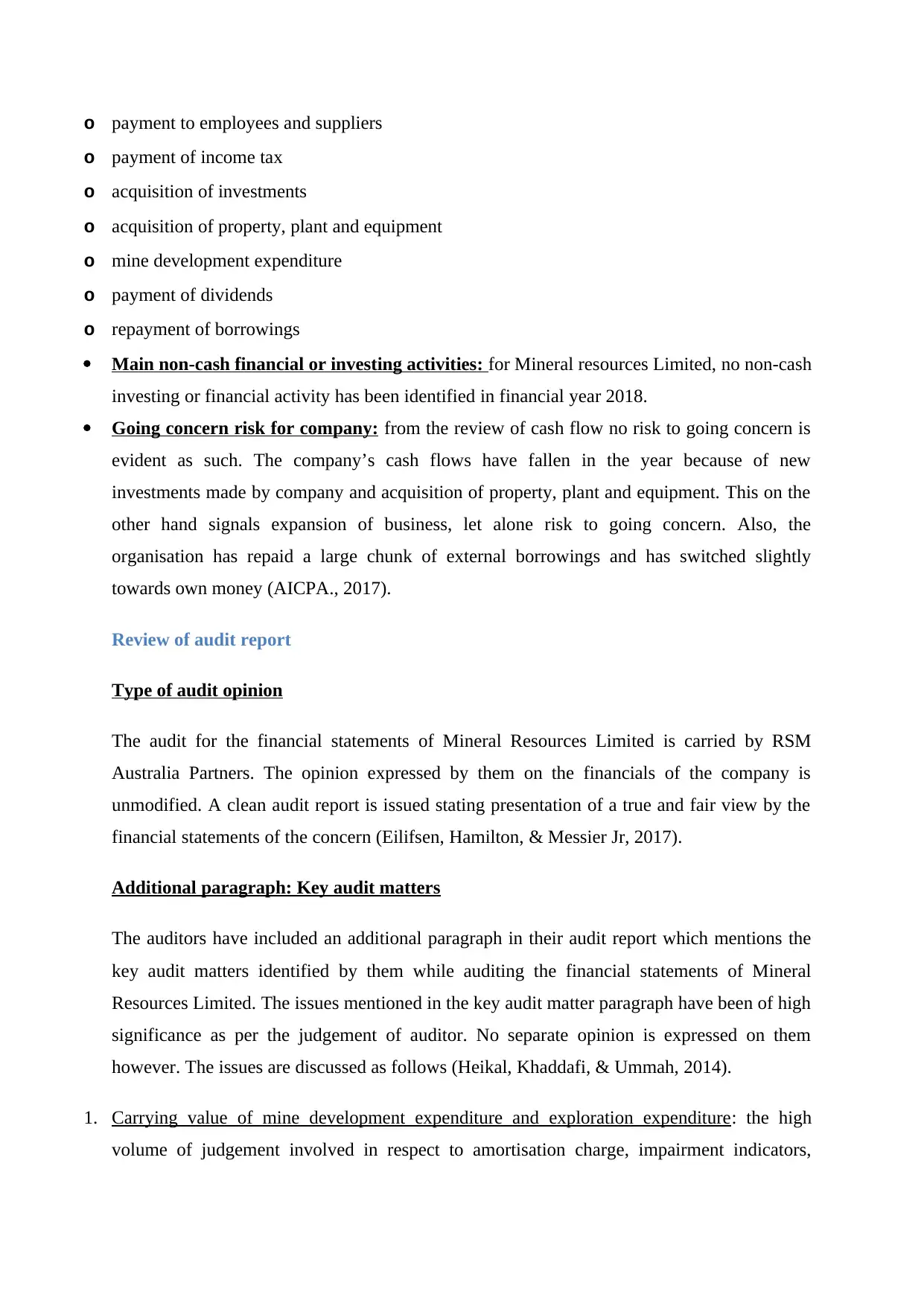
o payment to employees and suppliers
o payment of income tax
o acquisition of investments
o acquisition of property, plant and equipment
o mine development expenditure
o payment of dividends
o repayment of borrowings
Main non-cash financial or investing activities: for Mineral resources Limited, no non-cash
investing or financial activity has been identified in financial year 2018.
Going concern risk for company: from the review of cash flow no risk to going concern is
evident as such. The company’s cash flows have fallen in the year because of new
investments made by company and acquisition of property, plant and equipment. This on the
other hand signals expansion of business, let alone risk to going concern. Also, the
organisation has repaid a large chunk of external borrowings and has switched slightly
towards own money (AICPA., 2017).
Review of audit report
Type of audit opinion
The audit for the financial statements of Mineral Resources Limited is carried by RSM
Australia Partners. The opinion expressed by them on the financials of the company is
unmodified. A clean audit report is issued stating presentation of a true and fair view by the
financial statements of the concern (Eilifsen, Hamilton, & Messier Jr, 2017).
Additional paragraph: Key audit matters
The auditors have included an additional paragraph in their audit report which mentions the
key audit matters identified by them while auditing the financial statements of Mineral
Resources Limited. The issues mentioned in the key audit matter paragraph have been of high
significance as per the judgement of auditor. No separate opinion is expressed on them
however. The issues are discussed as follows (Heikal, Khaddafi, & Ummah, 2014).
1. Carrying value of mine development expenditure and exploration expenditure: the high
volume of judgement involved in respect to amortisation charge, impairment indicators,
o payment of income tax
o acquisition of investments
o acquisition of property, plant and equipment
o mine development expenditure
o payment of dividends
o repayment of borrowings
Main non-cash financial or investing activities: for Mineral resources Limited, no non-cash
investing or financial activity has been identified in financial year 2018.
Going concern risk for company: from the review of cash flow no risk to going concern is
evident as such. The company’s cash flows have fallen in the year because of new
investments made by company and acquisition of property, plant and equipment. This on the
other hand signals expansion of business, let alone risk to going concern. Also, the
organisation has repaid a large chunk of external borrowings and has switched slightly
towards own money (AICPA., 2017).
Review of audit report
Type of audit opinion
The audit for the financial statements of Mineral Resources Limited is carried by RSM
Australia Partners. The opinion expressed by them on the financials of the company is
unmodified. A clean audit report is issued stating presentation of a true and fair view by the
financial statements of the concern (Eilifsen, Hamilton, & Messier Jr, 2017).
Additional paragraph: Key audit matters
The auditors have included an additional paragraph in their audit report which mentions the
key audit matters identified by them while auditing the financial statements of Mineral
Resources Limited. The issues mentioned in the key audit matter paragraph have been of high
significance as per the judgement of auditor. No separate opinion is expressed on them
however. The issues are discussed as follows (Heikal, Khaddafi, & Ummah, 2014).
1. Carrying value of mine development expenditure and exploration expenditure: the high
volume of judgement involved in respect to amortisation charge, impairment indicators,
Paraphrase This Document
Need a fresh take? Get an instant paraphrase of this document with our AI Paraphraser
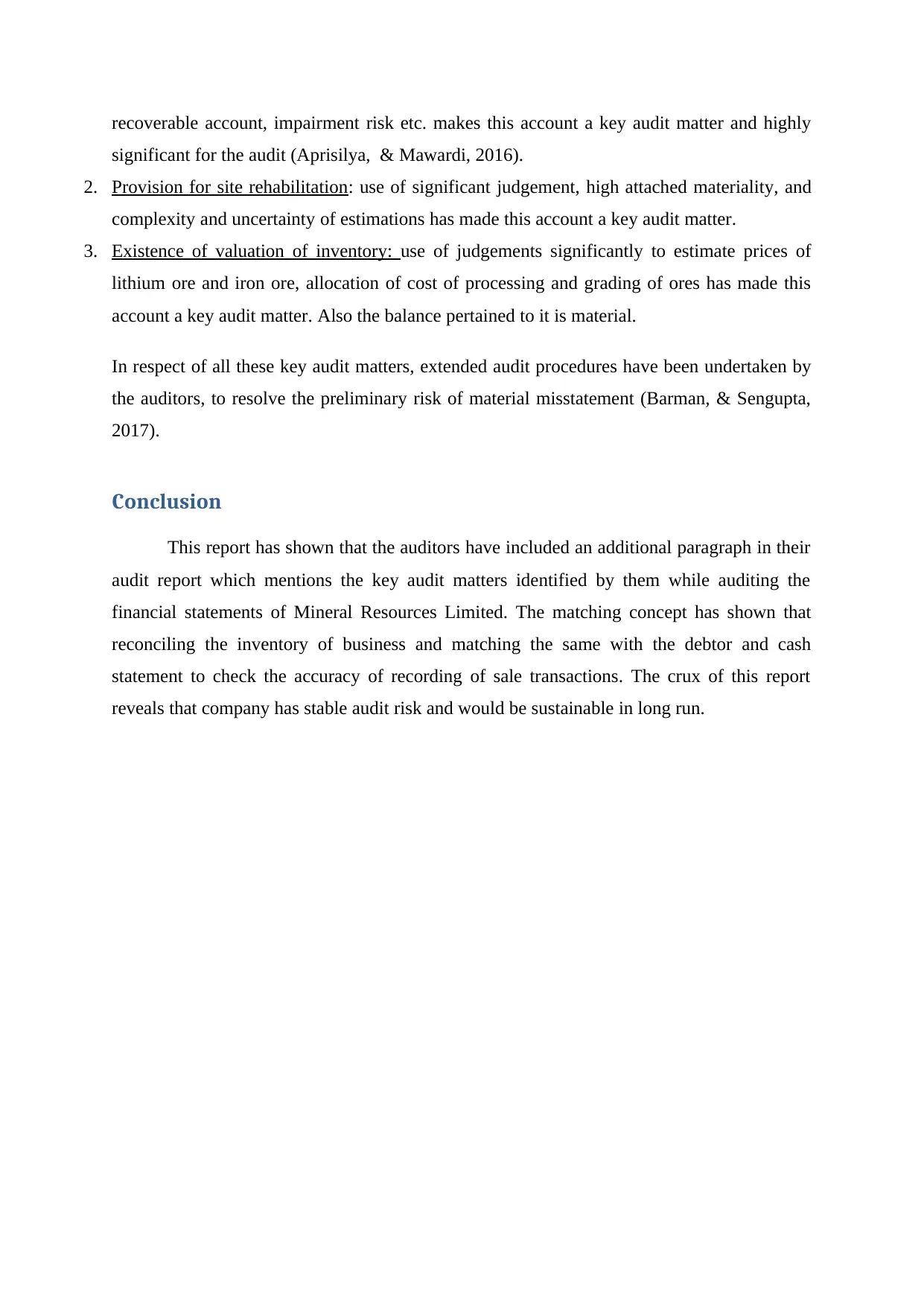
recoverable account, impairment risk etc. makes this account a key audit matter and highly
significant for the audit (Aprisilya, & Mawardi, 2016).
2. Provision for site rehabilitation: use of significant judgement, high attached materiality, and
complexity and uncertainty of estimations has made this account a key audit matter.
3. Existence of valuation of inventory: use of judgements significantly to estimate prices of
lithium ore and iron ore, allocation of cost of processing and grading of ores has made this
account a key audit matter. Also the balance pertained to it is material.
In respect of all these key audit matters, extended audit procedures have been undertaken by
the auditors, to resolve the preliminary risk of material misstatement (Barman, & Sengupta,
2017).
Conclusion
This report has shown that the auditors have included an additional paragraph in their
audit report which mentions the key audit matters identified by them while auditing the
financial statements of Mineral Resources Limited. The matching concept has shown that
reconciling the inventory of business and matching the same with the debtor and cash
statement to check the accuracy of recording of sale transactions. The crux of this report
reveals that company has stable audit risk and would be sustainable in long run.
significant for the audit (Aprisilya, & Mawardi, 2016).
2. Provision for site rehabilitation: use of significant judgement, high attached materiality, and
complexity and uncertainty of estimations has made this account a key audit matter.
3. Existence of valuation of inventory: use of judgements significantly to estimate prices of
lithium ore and iron ore, allocation of cost of processing and grading of ores has made this
account a key audit matter. Also the balance pertained to it is material.
In respect of all these key audit matters, extended audit procedures have been undertaken by
the auditors, to resolve the preliminary risk of material misstatement (Barman, & Sengupta,
2017).
Conclusion
This report has shown that the auditors have included an additional paragraph in their
audit report which mentions the key audit matters identified by them while auditing the
financial statements of Mineral Resources Limited. The matching concept has shown that
reconciling the inventory of business and matching the same with the debtor and cash
statement to check the accuracy of recording of sale transactions. The crux of this report
reveals that company has stable audit risk and would be sustainable in long run.
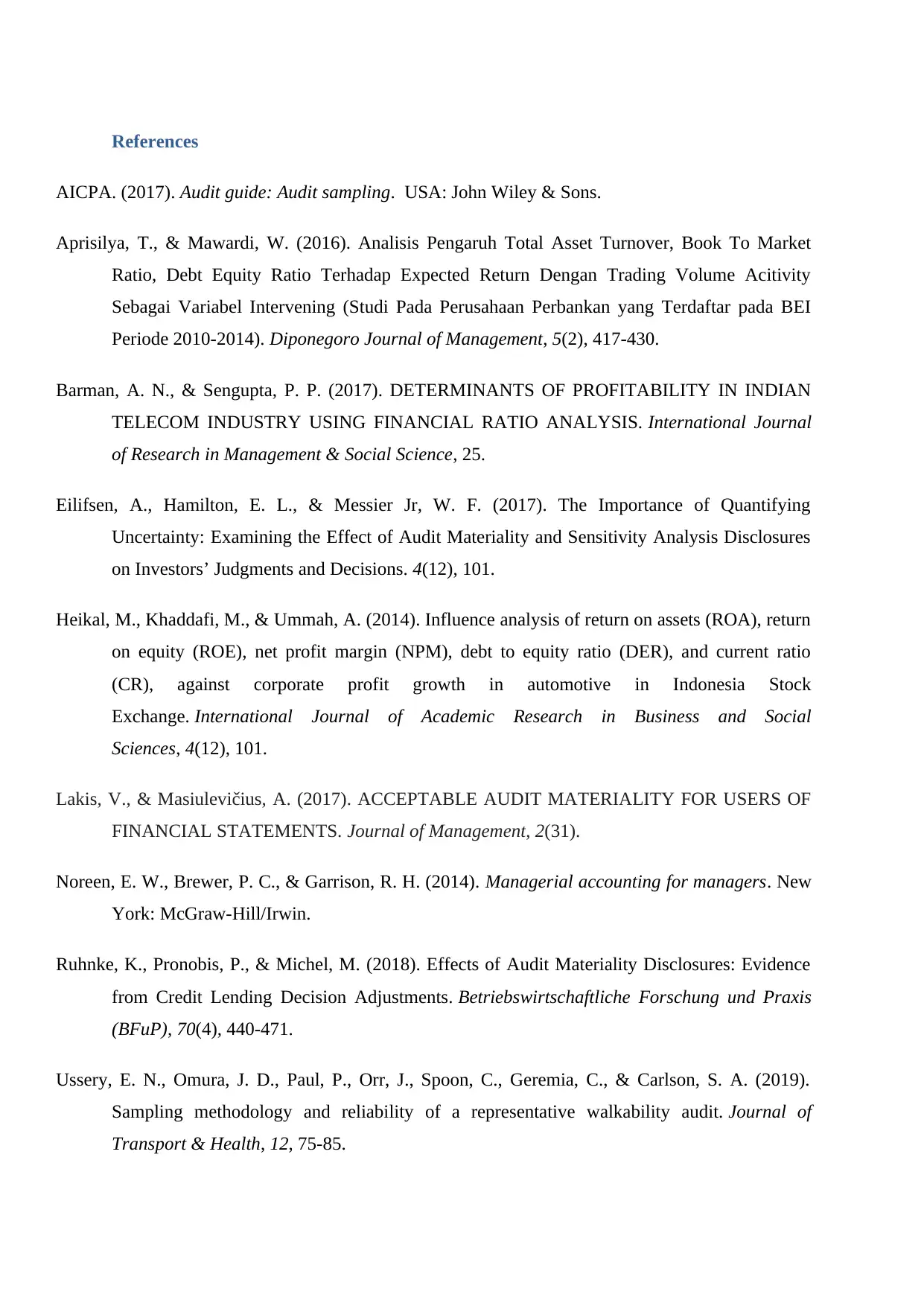
References
AICPA. (2017). Audit guide: Audit sampling. USA: John Wiley & Sons.
Aprisilya, T., & Mawardi, W. (2016). Analisis Pengaruh Total Asset Turnover, Book To Market
Ratio, Debt Equity Ratio Terhadap Expected Return Dengan Trading Volume Acitivity
Sebagai Variabel Intervening (Studi Pada Perusahaan Perbankan yang Terdaftar pada BEI
Periode 2010-2014). Diponegoro Journal of Management, 5(2), 417-430.
Barman, A. N., & Sengupta, P. P. (2017). DETERMINANTS OF PROFITABILITY IN INDIAN
TELECOM INDUSTRY USING FINANCIAL RATIO ANALYSIS. International Journal
of Research in Management & Social Science, 25.
Eilifsen, A., Hamilton, E. L., & Messier Jr, W. F. (2017). The Importance of Quantifying
Uncertainty: Examining the Effect of Audit Materiality and Sensitivity Analysis Disclosures
on Investors’ Judgments and Decisions. 4(12), 101.
Heikal, M., Khaddafi, M., & Ummah, A. (2014). Influence analysis of return on assets (ROA), return
on equity (ROE), net profit margin (NPM), debt to equity ratio (DER), and current ratio
(CR), against corporate profit growth in automotive in Indonesia Stock
Exchange. International Journal of Academic Research in Business and Social
Sciences, 4(12), 101.
Lakis, V., & Masiulevičius, A. (2017). ACCEPTABLE AUDIT MATERIALITY FOR USERS OF
FINANCIAL STATEMENTS. Journal of Management, 2(31).
Noreen, E. W., Brewer, P. C., & Garrison, R. H. (2014). Managerial accounting for managers. New
York: McGraw-Hill/Irwin.
Ruhnke, K., Pronobis, P., & Michel, M. (2018). Effects of Audit Materiality Disclosures: Evidence
from Credit Lending Decision Adjustments. Betriebswirtschaftliche Forschung und Praxis
(BFuP), 70(4), 440-471.
Ussery, E. N., Omura, J. D., Paul, P., Orr, J., Spoon, C., Geremia, C., & Carlson, S. A. (2019).
Sampling methodology and reliability of a representative walkability audit. Journal of
Transport & Health, 12, 75-85.
AICPA. (2017). Audit guide: Audit sampling. USA: John Wiley & Sons.
Aprisilya, T., & Mawardi, W. (2016). Analisis Pengaruh Total Asset Turnover, Book To Market
Ratio, Debt Equity Ratio Terhadap Expected Return Dengan Trading Volume Acitivity
Sebagai Variabel Intervening (Studi Pada Perusahaan Perbankan yang Terdaftar pada BEI
Periode 2010-2014). Diponegoro Journal of Management, 5(2), 417-430.
Barman, A. N., & Sengupta, P. P. (2017). DETERMINANTS OF PROFITABILITY IN INDIAN
TELECOM INDUSTRY USING FINANCIAL RATIO ANALYSIS. International Journal
of Research in Management & Social Science, 25.
Eilifsen, A., Hamilton, E. L., & Messier Jr, W. F. (2017). The Importance of Quantifying
Uncertainty: Examining the Effect of Audit Materiality and Sensitivity Analysis Disclosures
on Investors’ Judgments and Decisions. 4(12), 101.
Heikal, M., Khaddafi, M., & Ummah, A. (2014). Influence analysis of return on assets (ROA), return
on equity (ROE), net profit margin (NPM), debt to equity ratio (DER), and current ratio
(CR), against corporate profit growth in automotive in Indonesia Stock
Exchange. International Journal of Academic Research in Business and Social
Sciences, 4(12), 101.
Lakis, V., & Masiulevičius, A. (2017). ACCEPTABLE AUDIT MATERIALITY FOR USERS OF
FINANCIAL STATEMENTS. Journal of Management, 2(31).
Noreen, E. W., Brewer, P. C., & Garrison, R. H. (2014). Managerial accounting for managers. New
York: McGraw-Hill/Irwin.
Ruhnke, K., Pronobis, P., & Michel, M. (2018). Effects of Audit Materiality Disclosures: Evidence
from Credit Lending Decision Adjustments. Betriebswirtschaftliche Forschung und Praxis
(BFuP), 70(4), 440-471.
Ussery, E. N., Omura, J. D., Paul, P., Orr, J., Spoon, C., Geremia, C., & Carlson, S. A. (2019).
Sampling methodology and reliability of a representative walkability audit. Journal of
Transport & Health, 12, 75-85.
⊘ This is a preview!⊘
Do you want full access?
Subscribe today to unlock all pages.

Trusted by 1+ million students worldwide
1 out of 13
Related Documents
Your All-in-One AI-Powered Toolkit for Academic Success.
+13062052269
info@desklib.com
Available 24*7 on WhatsApp / Email
![[object Object]](/_next/static/media/star-bottom.7253800d.svg)
Unlock your academic potential
Copyright © 2020–2025 A2Z Services. All Rights Reserved. Developed and managed by ZUCOL.





